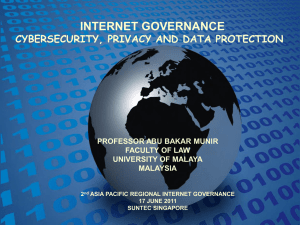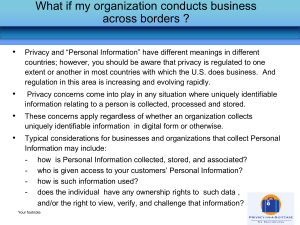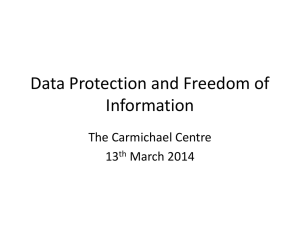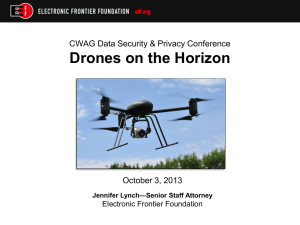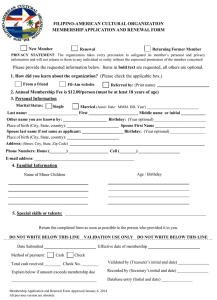DATA PROTECTION AND SECURITY IN CIVIL AVIATION
advertisement
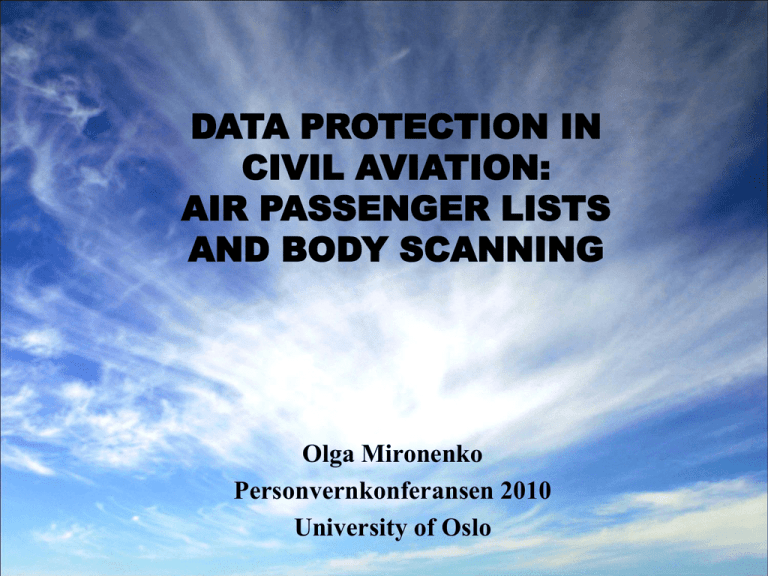
DATA PROTECTION IN CIVIL AVIATION: AIR PASSENGER LISTS AND BODY SCANNING Olga Mironenko Personvernkonferansen 2010 University of Oslo Introduction • The right to privacy and data protection are fundamental human rights. • Effective security must be ensured in the civil aviation sector. Such security measures as body scanners installed at airports and collection and transfer of air passenger data from airlines to the state authorities are intended to keep a high level of security and protect our lives. • These measures have a serious impact on privacy and data protection. ↓ A conflict arises between the use of these security measures and the protection of these rights. Dilemma • Is it possible to find an appropriate balance between the need for surveillance and privacy-related interests? • Is it possible to reach a situation when the persons’ rights to life and safe travelling would not be in conflict with their rights to privacy and data protection? Air passenger lists • Chicago Convention (1944) requires every aircraft to carry a list of passengers’ names and places of origin and destination. • 1960s - Hijacking as a threat for civil aviation. • 1990s - Computer Assisted Passenger Prescreening System in the USA • 9/11, Madrid 2004, London 2007 and other acts of terrorism. • 2001- The US Aviation and Transportation Security Act - the Passenger Name Records (PNR) system. • 2003 - CAPPS II, 2004 - Secure Flight (USA). • 2004 - 2008 - agreements on PNR transfer between the European Union and the USA, Canada and Australia. • New Zealand, South Korea, Japan, the UK are also using PNR data. • Many EU states have enacted primary legislation on PNR or are testing using PNR data. • 2007 - Proposal of the European PNR system. Advanced Passenger Information (API) Passenger Name Record (PNR) API Guidelines by WCO, IATA and ICAO (2003) PNR Data Guidelines by ICAO (2005) Collected on behalf of governments Airlines collect PNR for their own needs Serve border control and immigration purposes Initially served commercial purposes Derive from travel documents information (machine readable zone of a passport) All the data that the passenger submits to the reservation system (up to 60 fields). May include sensitive data. Data cannot be deleted, even if cancelled. The system is not restricted to a specific flight. Include data on other customers. Contain only validated biographical data Completeness or accuracy not guaranteed. May not be fully updated on the date of departure. The data is captured by the carrier prior to the departure PNR may be created in a reservation system up to 360 days in advance API records are created for each passenger May include multiple passengers within the same record; data on several people: traveler, agent, staff, person paying for the ticket... Right to data protection is protected by a number of international instruments. Data protection principles: • Collection limitation principle • Data quality • Purpose specification • Use limitation • Security and confidentiality • Transparency and data subject participation • Accountability • The transfer of personal data from the EU to the countries lacking adequate level of protection is prohibited. Protection afforded by the USA • The USA is not legally bound by any of the international data protection instruments. • In the USA the right to privacy is protected by common law mechanisms. • Privacy Act of 1974 protects personal information only when it is processed by the federal government. • The USA has no general law protecting the privacy of “commercial” data. • The USA cannot be considered as a country with adequate level of data protection. As the result: After the introduction of the new security measures in the USA, the European airlines found themselves in a difficult situation: to fly from the EU to the USA refuse to transmit the data, thereby becoming ,. subject to US authorities’ sanctions ? deliver the data in violation of the EU law EU – USA PNR Agreement (2004, 2006 and 2007) • The negotiations were pushy on the US side of the table. • Despite the parties tried to provide “safeguards”, the agreement failed to offer an adequate level of data protection and left many problems open. • The agreement was needed ASAP to avoid legal uncertainties for the EU member states, passengers and carriers, thus it was preferable to have an agreement with weaknesses and shortcomings, rather than not to have one at all. • The agreement was more a political solution than a legal instrument. • The deal provoked widespread privacy and security concerns. • US is still trying to dictate tougher restrictions and get additional data from EU member states individually. The weakest points of the Agreement: • • • • • • • • • • • • legal force and effect inadequate data protection standards scope of the agreement uncertainty lack of purpose limitation “pull”/”push” system issues unclear joint review procedure extended retention period enlarged list of data fields sensitive data issues no clear list of US authorities entitled to access PNR problem of enforcement of rights by the EU citizens dependence on change in the US legislation, etc. Proposed European PNR System • It is not mentioned, but EU-USA PNR agreement is used as a model. Thus Proposal suffers many of the same weaknesses. • Decentralized system of data collection. • No substantial evidence is actually given that the collection of passenger data is necessary and adds value to the fight against terrorist offences and serious crime • Unclear relationship with other measures, such as Electronic System for Travel Authorization (ESTA), biometrics in passports, Schengen Information System (SIS), Visa Information System (VIS), national border protection schemes. • Reports published by other agencies which had previous experience with PNR, such as the Government Accountability Office in the US, Germany and the UK did not confirm the efficiency of the measures. BODY SCANNERS • 1992 - The first body scanner was created by Dr. Steven Smith in the USA. • 2007 - The first airport (Schiphol, the Netherlands). • 25 December 2009 - “underwear bomber”. • The list of airports currently deploying scanners is constantly growing (USA, Canada, the UK, Russia, etc.) • The ICAO does not give any guidance on scanners. • No common definition of a “body scanner”. Various terms are in use: “security scanner”, “whole-body scanning”, “advanced imaging technology”, “digital strip searchers”... • Are deemed to be one of the technical solutions required to keep a high level of security and to protect our lives. • Have a serious impact on privacy and data protection as well as other rights (rights of the child, freedoms of thought, conscience and religion, right to freedom of movement…) and health (possible harms from radiation). Several technologies have been developed: X-ray backscatter Terahertz waves Active millimeter wave X-ray transmission imaging technology The USA • The Transportation Security Administration (TSA) began deploying advanced imaging technology in 2007. • There are currently 385 imaging technology units at 68 airports. • By 2014 the USA plans to deploy 1800 scanners in order to gradually introduce them as a primary screening method. • 22 April 2009 - the US House of Representatives passed “Aircraft Passenger Whole-Body Limitations Act of 2009”. • A bill introduced in the US Senate in 2010 - Securing Aircraft From Explosives Responsibly: Advanced Imaging Recognition Act (S.A.F.E.R. A.I.R. Act) makes scanners the primary screening technology by 2013. • Opinions of opponents receive wide coverage in the press and Internet (for example, the incident in San Diego on 13 November 2010). • On 2 July 2010, the Electronic Privacy Information Center filed a lawsuit to suspend the deployment of body scanners at US airports. The European Union • The use of scanners is not currently regulated at the EU level. • Member states may deploy the scanners either by exercising their right to apply security measures that are more stringent than existing EU requirements or by exercising their right to conduct trials of new technical processes or methods for a maximum period of 30 months. • 5 September 2008 the European Commission proposed a draft regulation including basic screening requirements to be further developed in legislation. • 23 October 2008 – request of an impact assessment by the EP. • 15 June 2010 - the Commission’s Report which assesses the current situation with regard to the use of security scanning technology. • Formal trials of scanners were undertaken in Finland, the UK, the Netherlands, France, Italy and Germany. • The UK intends to deploy scanners at all UK airports. • Finland and Italy – decided to discontinue the use of scanners. Right to privacy According to the European Convention on Human Rights of 1950, • Everyone has the right to respect for his private and family life, his home and his correspondence“ - Article 8 (1) • There shall be no interference by a public authority with the exercise of this right except such as is in accordance with the law and is necessary in a democratic society in the interests of national security, public safety or the economic well-being of the country, for the prevention of disorder or crime, for the protection of health or morals, or for the protection of the rights and freedoms of others” - Article 8 (2) Privacy Applicability of ECHR Art. 8 (1): • The European Court of Human Rights has given ECHR Article 8 a very broad interpretation. • The concept of private life includes elements relating to a person's right to their image. • The mere storing of data relating to the private life of an individual amounts to an interference. Applicability of ECHR Art. 8 (2): Given applicability of Article 8 (1), it is important to indicate: • whether the interference is in accordance with the law. • if the scans satisfy to the legitimate aim, proportionality and necessity principals. “Scanned images of persons as if they were naked, equivalent to a virtual strip search” (EP, 2008)? Safeguards for privacy Con arguments black and white silhouettes with blurred faces and other areas of the body reveal very sensitive areas of private life and conditions, such as prostheses, breast implants, diapers, menstrual pads… analysts are in separate rooms abuses (for example, in Lagos airport) analyst of the same gender (EU, UK) alternative screening methods (USA, EU) not all airports have capacity and staff exemptions for the vulnerable groups a concurrent risk that terrorists would then recruit children the image would not be saved and would be destroyed the breach of privacy is constituted by first the production and then the analysis of the image the right to privacy can be considered as waived by the passengers since the travelers make agreements with airlines which include security requirements not all such waivers are automatically effective (ECtHR case law: a waiver, to be successful, must be unequivocal and attended by minimum standards) Do the scans add value in the war on terrorism and crime? Pro arguments • The governments claim that the use of the machines is justified and necessary in order to heighten security measures at airports and better protect the traveling public. • They are considered to be more effective than metal detectors as they are capable of identifying both metallic and non-metallic objects, including plastic and liquid items. • They are supposed to improve passenger flow. In contrast to manual searches requiring 2–3 minutes, the machines take only seconds to produce and interpret passenger data. • Such an enhanced detection performance might also be achieved by a full physical hand search (so-called “pat-down“) or strip-search, but the use of scanners are thought to be quicker and less invasive. Contra • Cannot detect explosives carried inside the body. • May not be able to distinguish foreign objects such as prosthetics and weapons. The percentage of false positives is high and it may increase the need for manual searches. False alarms Missing objects • An extremely finite period of time means evidence might be missed. Moreover, the operators may not have the required technical expertise to intercept the data. (2) • A price of a basic scanner: EUR 100 000 - 200 000 per item, excluding training, installation, and maintenance costs. • The scanners are being implemented as a reaction to past situations. According to many security experts, such an approach will fail to anticipate the next bomber. • Measures taken to address privacy concerns over the use of the scanners may dampen the machines' effectiveness in locating arms and explosives. • While it can be acknowledged that there is a legitimate aim for the invasion of privacy, the effectiveness of scanners is questionable. Even if it is accepted that their use is necessary and proportionate, serious concerns about whether the intrusion is in accordance with the law still remain. Thus, it can be hardly stated that Article 8 (2) permits the limitation of privacy. Right to data protection The storage and retrieval of images • The governmental agencies say the images cannot be stored, transferred, copied, or printed, and are permanently removed. BUT • There is lack of complete, comprehensive and reliable information about what the devices actually are. • The agencies need to retain the images as evidence, for testing and training purposes, or for later inspection to find out what went wrong with the scans if there were a successful terrorist attack. • The TSA's Procurement Specs require that the machines have the ability to record and transmit images. • According to a letter from 15 April 2010 from TSA to EPIC, the TSA possesses about 2000 body scanner photos from devices that the TSA said earlier “could not store or record images”. • The experts also admit that the images are still being captured and stored by these “changed” devices. Information to passengers • The US S.A.F.E.R. A.I.R. Act: passengers shall be provided with (i) information about the images; (ii) information regarding the privacy protections; (iii) sufficiently detailed notice and an explanation of the alternative option for primary screening. • The EU Commission proposes that appropriate, comprehensive and clear information on all aspects of scanner usage should be provided to the public at airports, before travelling. • These proposals do not give sufficient details about how appropriate, comprehensive and clear information can be provided to the passengers in reality, before travelling and before purchasing the tickets, and who will be responsible for the information provision. This could at least enable the passengers to make an informed decision as to whether they wish to be scanned or not (if alternative methods are available) and/or whether or not to fly. Excessive measure? • If alternative and less intrusive screening methods are available, and if an individual is concerned about the implication of scans (due to disability, pregnancy, or other reasons) and consents to the alternative methods, then it may be considered excessive to require such a person to go through a scan. In summary it can be concluded that deployment of scanners cannot be currently regarded as in compliance with all the established data protection requirements and privacy standards. Future? Will new technologies determine the future in aviation security? • One of the companies states that it is working on a system that would not require passengers to stop and stand still • Flight Assistance Security Trolley • Automatic Threat Recognition • The X-ray transmission imaging technology can detect explosives carried internally BUT overreliance on technology may have a negative effect • technology can never be the “sole solution”, but only a means of reacting • 100% security can never be achieved The latest tendencies • what is really needed is to change the system • instead of reacting to past situations, there should be an intelligence-led system, with an element of randomness and unpredictability in security screening and the use of technology • “behavioural analysis techniques”: it would then be at the discretion of the security staff to choose the appropriate screening techniques or technology • “targeted passenger profiling” (although these techniques may raise separate human rights and equalities issues) • with such an approach there may be no need to scan all passengers. Conclusion • The use of both PNR systems and body scanners is increasing. • While there are doubts about whether they add value to the war on terrorism and crime, it is quite obvious that these measures expose passengers to a significant loss of privacy and data protection rights. • There appear many political and economic issues and policies, which greatly affect the security and privacy regime. It might be extremely difficult to find solutions, especially internationally. • The point is that breaching people’s rights and freedoms can be justified under human rights legislation. But every security measure has to be clarified, justified and accompanied by strong and adequate safeguards. • In the meantime the governments have failed to demonstrate that the measures are currently justifiable within the law. The proposed “safeguards” contain weak privacy provisions. • Different organizations urge the governments to suspend the airport body scanner program until a comprehensive evaluation of the devices' effectiveness, health impacts, and privacy safeguards has been completed by an independent board of review. THANK YOU Comments? Questions? olga.mironenko@jus.uio.no
